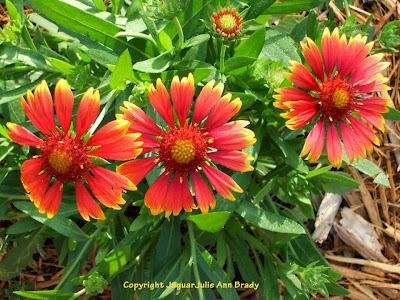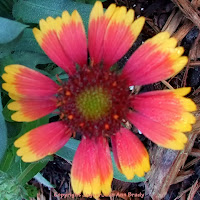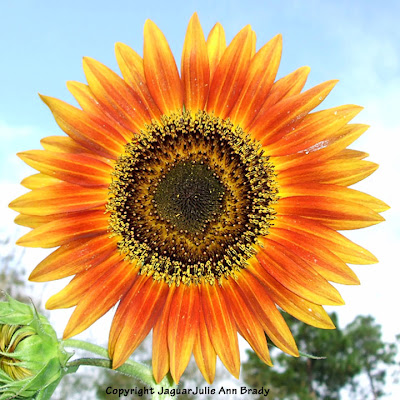Help! My yard has been overtaken by this weed that really grows like a weed. At first glance, I thought the initial appearance of that weed was a sprig of grass! After the initial growth, it will start to grow and double up on the green shoots. See if you can identify this weed for me and give me some tips on what to do about it.
 |
| New growth of a mystery weed that has tiny lavender-purple flowers |
This new growth of the mystery weed shows how the roots are quite plentiful. There are many tiny fibrous roots which seem to spread out like an umbrella. Once the weed has taken hold, those roots will clump up to hold the dirt and sand. Digging up a patch of this weed, it is quite heavy from holding all that soil.
 |
| That mystery weed that has tiny lavender-purple flowers |
Gosh, I thought mulch was supposed to discourage the growth of weeds? You can see about 4 different "sprigs" of those mystery weeds emerging through my 100% cypress mulch. That picture is actually from my sunflower garden. At first look, you see a tiny bit of growth that resembles grass. Next you see this and then after that ... BAM! you will have ground cover with a network of roots that grab the sandy soil and take hold.
This green weed is really like a ground cover as it will snake through the St. Augustine grass to overtake the yard. I had a bit of this weed last Summer in my front side yard. I dug that up and put in
my second Mexican Petunia garden. I went nearly one year before I saw that weed again; and this time, it was all over the yard!
 |
| That mystery weed with tiny lavender-purple flowers takes over the yard! |
In the above picture, that mystery weed has taken over a patch of my yard. That's a picture after I cut the grass [and weeds]. I had waited two weeks to cut that patch of grass. The cut weed was a bit slimy and sticky. I found that the cut weed was sticking to the blades of my lawn mower. You can't really see the tiny purple flowers in that picture.
 |
| That mystery weed with tiny lavender-purple flowers - look closely! |
In this last photo, you can see some of the tiny lavender-purple flowers. Gosh, you'd think this is really grass with flowers! To the trained and informed eye, you can pick out the weed from the St. Augustine grass. This weed is a different green - it is a couple of shade lighter. If you find a new shoot of the weed, you can usually pull it up quite easily.
Identify That Weed Please!
I hope one of my readers out there can help me! What's curious is that this year, throughout the various months, I added a variety of products to my St. Augustine grass. They included these:
- Scotts Turf Builder WinterGuard Lawn Fertilizer
- Scotts 49805A Halts Crabgrass Preventer
- Scotts Bonus S Weed and Feed
- Milorganite 0636 Organic Nitrogen Fertilizer
- Scotts Super Turf Builder SummerGuard Lawn Fertilizer
I also used some Spectracide 53944 Triazicide Once and Done Insect Killer Granules. Last Summer, I put down about 80 pieces of St. Augustine sod in my front yard. Because that was a back-breaking job, I wanted to be sure to keep my grass looking nice and healthy this year.
For the most part, my front yard is good - that creepy, crawly weed with the tiny lavender-purple flowers hasn't taken hold there - knock wood!
What I am seriously wondering? The Milorganite was also spread through the rest of the yard. Could it be that this is the fertilizer that stimulated the growth of that mystery weed?
Can anyone help?
UPDATE: Thus far I have not had anybody conclusively identify this weed! After receiving a Scott's email, I took a look at their site and was reading about
purple nutsedge and
purple nut grass along with
yellow nutsedge and
kyllinga nutsedge. Googling purple nutsedge, I just admit that I did see a picture which looks a lot like the new growth picture of my mystery weed!
Take two! I happened upon a page about
Common Florida Weeds. Checking out the pictures, yes, I recognized many of those common weeds. Then, I saw their picture on
matchweed -
Phyla nodiflora. Boy oh boy, that sure does look like my weed. It is "a mat-forming perennial with opposing leaves on hairy branching stems. Leaves have small teeth at the outer tip. The purple to white flowers emerge around the tip of the seed stalk forming a match-head appearance."
On that same page about common weeds in Florida, I found out the name of another "weed" that I've seen in abundance in my yard. It is
Alexander grass and in the same area where that weed took hold, you can find that other mystery weed, possibly the matchweed.
Searching further, I found another weed that resembles my mystery weed. It is
doveweed - Murdannia nudiflora (L.) Brenan or Aneliema nudiflorum (L.) Kunth. Here is the clincher: "It is classified as an annual grass-like weed which makes it difficult to kill because it is a distant relative of turfgrasses such as St. Augustine." I remember the last time I was in Lowe's looking for a crabgrass preemergent, the gal in the garden department told me that crabgrass is a relative of St. Augustine grass. Hey! How do I get rid of all the relatives in my St. Augustine grass?
ANOTHER UPDATE: So, the end of October, Peninsular Pest Control was treating the neighbor's yard. I asked one of the fellows what he was putting down. He said fertilizer and pre-emergent. The application looked mighty "substantial." Then, I asked him to take a look at the weed that populated my backyard. After digging a bit at the weed and pulling it up, he said, "it looks like buttonweed." I Googled "buttonweed" and came upon a
Missouri State Education site with pictures. By golly, that sure looks a lot like a good bit of the weeds in my backyard. However, they describe the tiny flowers as white to pink. I really think the color is more pale purple or lavender. I do have the variety of this weed with tiny white flowers. That weed is also known as Povertyweed, Poorjoe, Dioidia, and/or Rough Buttonweed.









































